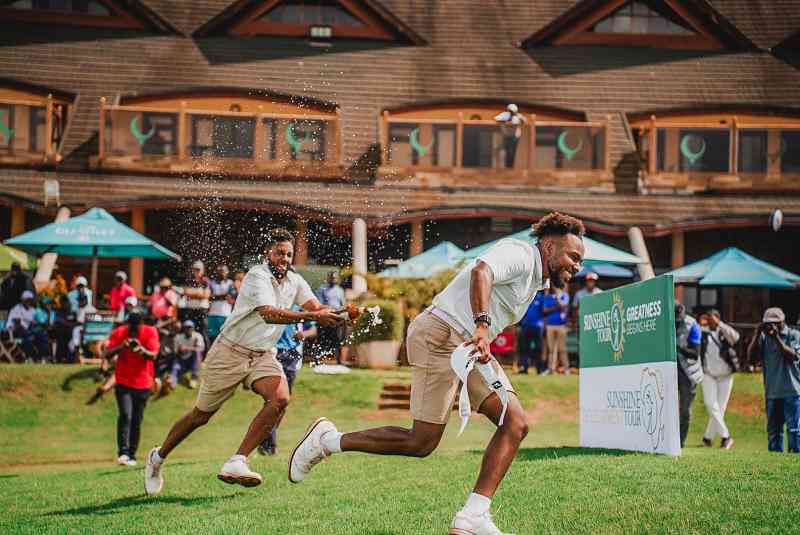Windsor Golf Hotel & Country Club’s Njoroge Kibugu celebrates after winning the opening leg of the 2025-2026 season of the Sunshine Development Tour—East Africa Swing event at the Thika Green Golf Resort on Wednesday, June 5, 2025. [Sunshine Tour]
Kenya and East Africa’s hopes of having golfers at the 2028 Los Angeles Olympic Games remain alive—but the road ahead is steep and demanding.
With the qualification process based on global rankings, golfers from the region will need to work their way into the world’s top 350 to stand a realistic chance of representing their countries.
Golf’s return to the Olympic stage in 2016 after more than a century was a historic moment for the sport. Since then, the Olympics have become one of golf’s most prestigious stages, offering global recognition and major championship exemptions to medal winners.
However, unlike athletics, where qualification is achieved through time or distance, Olympic golf depends heavily on the Official World Golf Ranking (OWGR) for men and the Women’s World Golf Rankings (WWGR) for women.
Follow The Standard
channel
on WhatsApp
Under the International Golf Federation (IGF) system, the top 15 golfers in the world automatically qualify, with a limit of four players per country. Beyond that, countries can field up to two players each, provided they are ranked high enough.
The qualification format, used at the Tokyo 2020 and Paris 2024 Games, will remain the same for Los Angeles 2028.
That means for any East African golfer to make the cut, they must be ranked within the top 350 in the world.
Currently, the region’s leading professionals are still far from that mark. Rwanda’s Celestin Nsanzuwera is the highest-ranked East African golfer at position 1,782, followed by Kenya’s Njoroge Kibugu at 1,896 and veteran Dismas Indiza at 2,217.
The trio have benefited from the newly established Sunshine Development Tour (SDT), the only OWGR-recognised professional golf circuit in East Africa.
Through its events, players can earn ranking points without having to travel to South Africa or Europe. But with limited tournaments on the calendar, the region’s professionals face a difficult task climbing the rankings in time for the 2028 Games.
According to David Kihara, Tournament Director, SDT-East Africa Swing, the organisation of more tournaments will give East African players a good chance to make the cut.
“For Kenyan golfers to make it into the global scene, they need consistent tournaments that offer them a pathway to the international stage. Such a pathway can only be possible if our golfers have access to tournaments that offer Official World Golf Ranking (OWGR) points—which is the benchmark used the world over to rank golfers,” said Kihara.
“For years, we have not had such a chance until now with the Sunshine Development Tour—East Africa Swing. Now, our golfers have a chance to earn OWGR points, which will raise their profiles and open opportunities for them to access tours and affiliations with a global stature, such as the Sunshine Tour, the DP World Tour, the PGA Tour and so on. At the same time, our players now have a golden chance of qualifying to play the forthcoming Olympics, as OWGR points ranking is what is used to determine qualification into the games.”
Asked if the current pathway is fair for all golfers, Kihara said:
“The pathway, as it is with all tours around the world, is purely merit-based and applies the same across the board amongst all the participants. It is open to elite amateurs and professionals – both men and women – with a player’s effort, focus, and resolve determining how far they go in the pathway. So, yes: the pathway offers a fair and equal playing field for all involved.”
Kericho Golf Club’s Collins Kipkirui believes that SDT is a vital step forward but says more needs to be done to give local golfers a realistic shot at Olympic qualification.
“This is a good pathway to the Olympics 2028 and other Olympics to come,” Kipkirui said.
“The Sunshine Development Tour has offered a chance to potential golfers around East Africa, but there is need to get more events like this one for a bigger chance not only to participate but also to win. Golf clubs across the country must understand the tour, its benefits, and future perspective.”
He emphasised that for Kenya to produce Olympic-level golfers, grassroots development and modern coaching must be prioritised.
“Junior golf academies and activities across the country must be nurtured, funded, and supported,” Kipkirui added.
“More coaches should be trained on current coaching skills. This will help create sustainable programmes and prepare more individual golfers to contest at elite competitions.”
For Kenya, this means strengthening youth programmes under the Kenya Golf Union and ensuring that local professionals get more chances to compete in OWGR-sanctioned events.
With the SDT offering the only recognised route to global ranking points, expanding its reach and frequency could make all the difference.
If local golfers can regularly compete and earn points, climbing into the top 1,000 — and eventually the top 350 — becomes achievable. Without that, Olympic dreams will remain out of reach.
The pathway to Los Angeles 2028 may be tough, but for East African golfers, the foundation is finally being laid.


